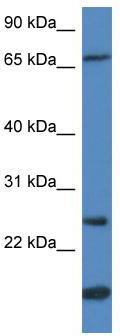GSTM5 Rabbit Polyclonal Antibody
Frequently bought together (3)
Transient overexpression lysate of glutathione S-transferase mu 5 (GSTM5)
USD 396.00
Other products for "GSTM5"
Specifications
| Product Data | |
| Applications | WB |
| Recommended Dilution | WB |
| Reactivities | Human |
| Host | Rabbit |
| Isotype | IgG |
| Clonality | Polyclonal |
| Immunogen | The immunogen for anti-GSTM5 antibody: synthetic peptide directed towards the N terminal of human GSTM5. Synthetic peptide located within the following region: MPMTLGYWDIRGLAHAIRLLLEYTDSSYVEKKYTLGDAPDYDRSQWLNEK |
| Formulation | Liquid. Purified antibody supplied in 1x PBS buffer with 0.09% (w/v) sodium azide and 2% sucrose. Note that this product is shipped as lyophilized powder to China customers. |
| Purification | Affinity Purified |
| Conjugation | Unconjugated |
| Storage | Store at -20°C as received. |
| Stability | Stable for 12 months from date of receipt. |
| Predicted Protein Size | 26 kDa |
| Gene Name | glutathione S-transferase mu 5 |
| Database Link | |
| Background | Cytosolic and membrane-bound forms of glutathione S-transferase are encoded by two distinct supergene families. At present, eight distinct classes of the soluble cytoplasmic mammalian glutathione S-transferases have been identified: alpha, kappa, mu, omega, pi, sigma, theta and zeta. This gene encodes a glutathione S-transferase that belongs to the mu class. The mu class of enzymes functions in the detoxification of electrophilic compounds, including carcinogens, therapeutic drugs, environmental toxins and products of oxidative stress, by conjugation with glutathione. The genes encoding the mu class of enzymes are organized in a gene cluster on chromosome 1p13.3 and are known to be highly polymorphic. These genetic variations can change an individual's susceptibility to carcinogens and toxins as well as affect the toxicity and efficacy of certain drugs. Diversification of these genes has occurred in regions encoding substrate-binding domains, as well as in tissue expression patterns, to accommodate an increasing number of foreign compounds. [provided by RefSeq, Jul 2008] |
| Synonyms | GSTM5-5; GTM5 |
| Note | Immunogen Sequence Homology: Pig: 100%; Human: 100%; Dog: 93%; Goat: 93%; Horse: 93%; Bovine: 93%; Rat: 86%; Mouse: 86%; Rabbit: 85%; Guinea pig: 85% |
| Reference Data | |
| Protein Pathways | Drug metabolism - cytochrome P450, Glutathione metabolism, Metabolism of xenobiotics by cytochrome P450 |
Documents
| Product Manuals |
| FAQs |
| SDS |
{0} Product Review(s)
0 Product Review(s)
Submit review
Be the first one to submit a review
Product Citations
*Delivery time may vary from web posted schedule. Occasional delays may occur due to unforeseen
complexities in the preparation of your product. International customers may expect an additional 1-2 weeks
in shipping.






























































































































































































































































 Germany
Germany
 Japan
Japan
 United Kingdom
United Kingdom
 China
China



